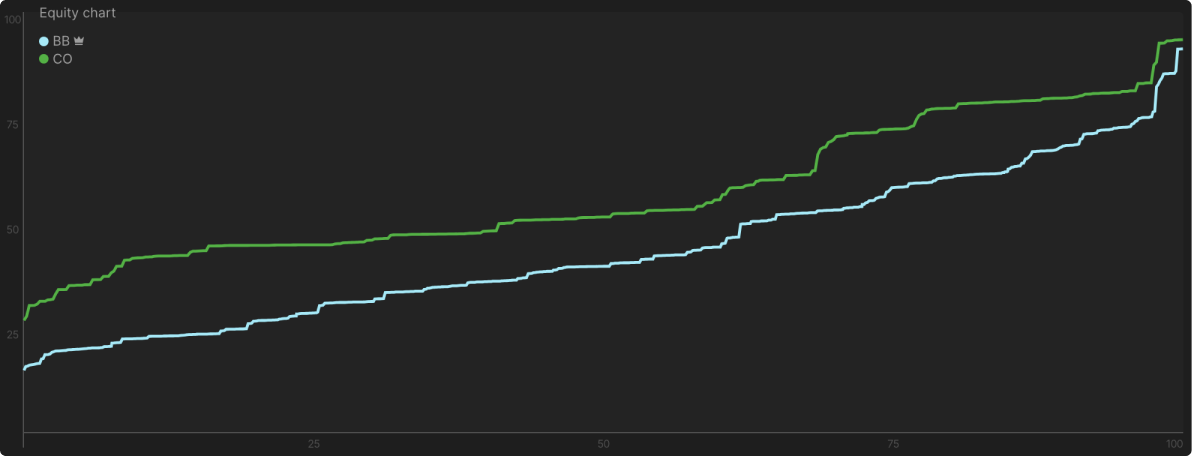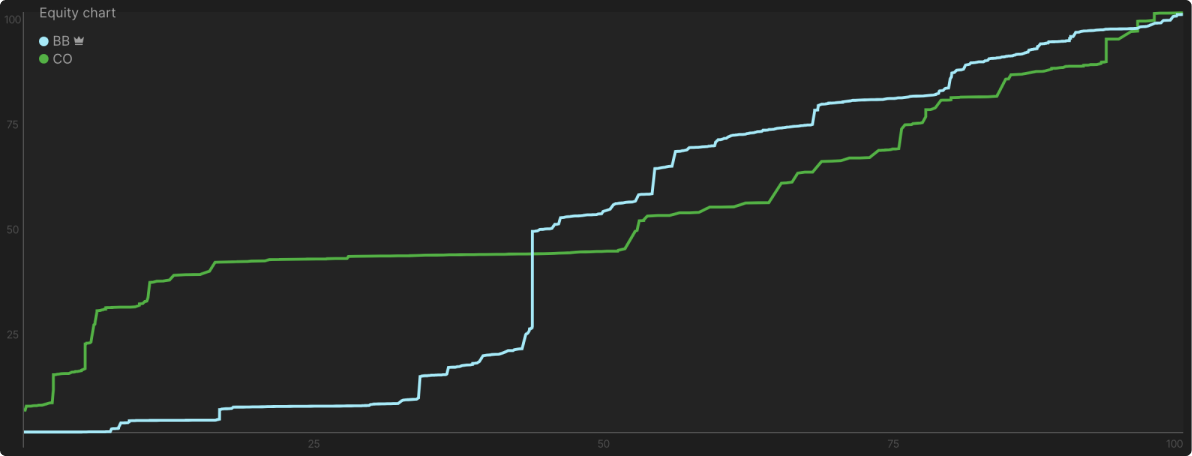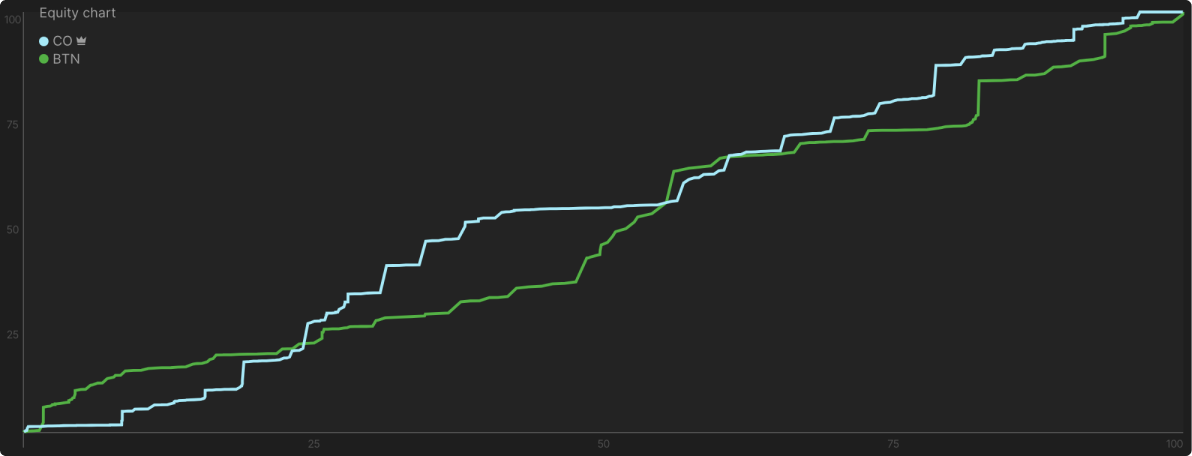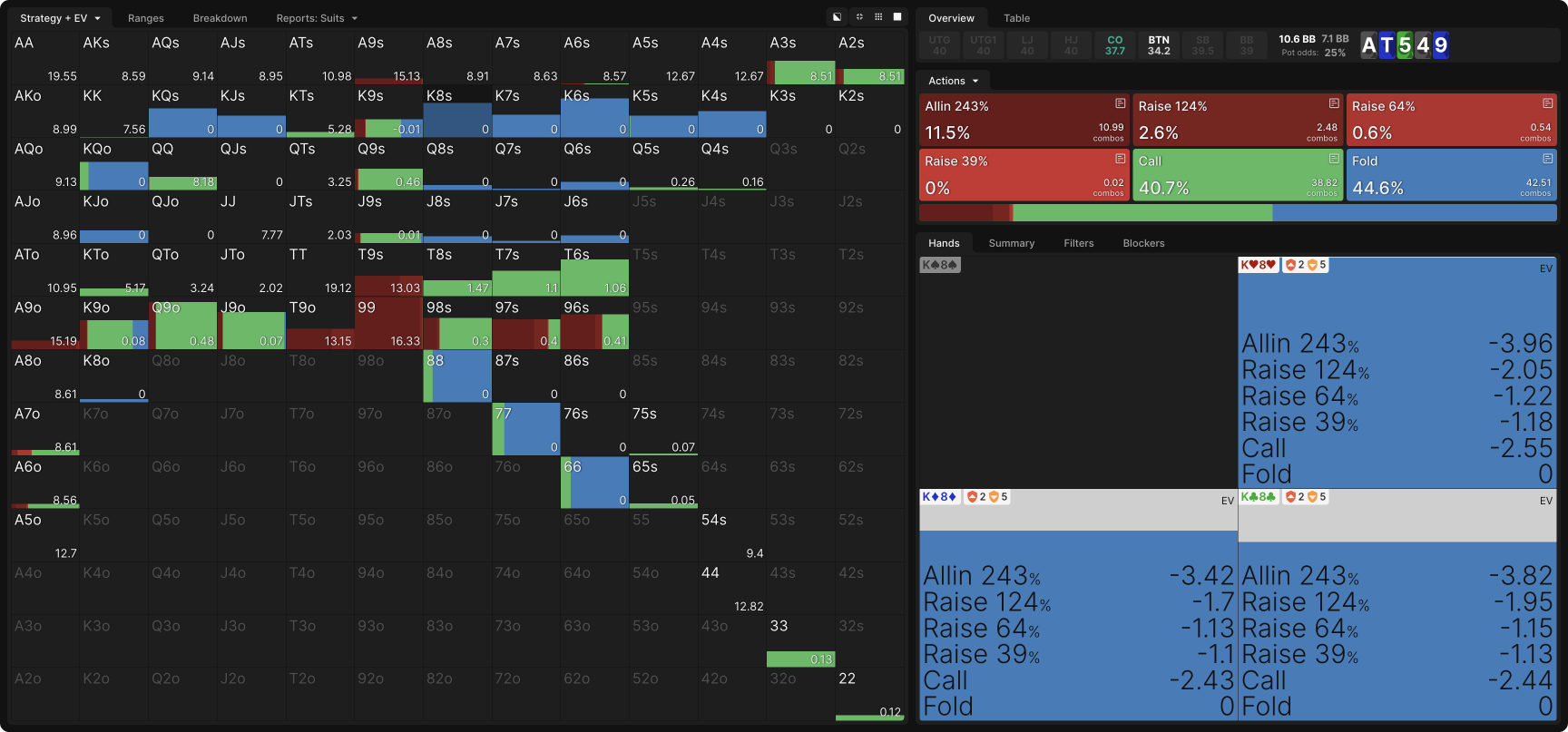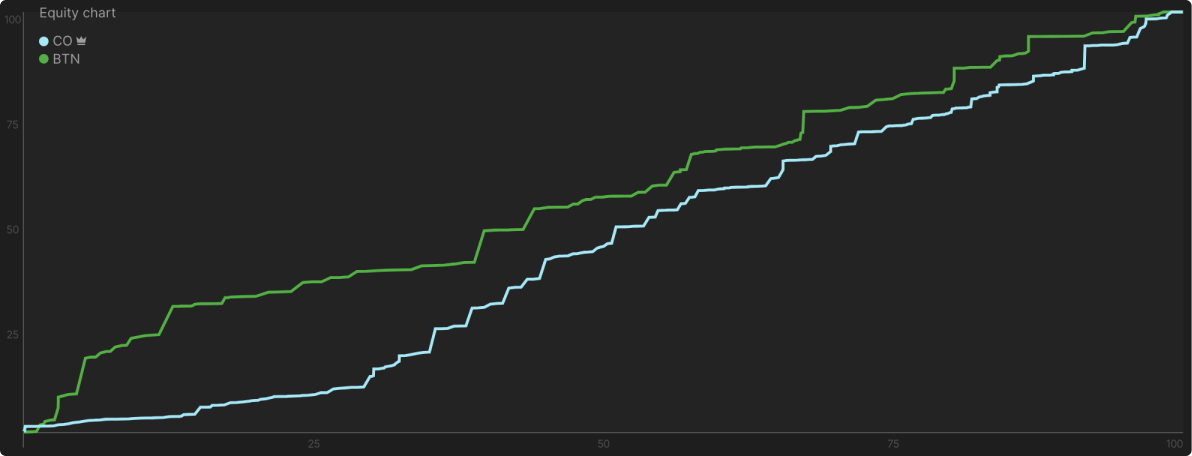Mastering Thin Value Bets in Checked-Down Pots
Valuing your hand appropriately—determining whether it’s strong enough to value bet or so weak you should consider bluffing—requires synthesizing information from two sources: the face-up community cards and the actions of the other players, which provide clues about the strength of their hands.
Most players are more comfortable with the former than the latter, which results in significant mistakes in pots where there was no betting on the flop and turn. In such scenarios, all players will likely have fairly weak ranges, which means you can value bet quite thinly. It also means the rank of your unpaired hand will likely be relevant in determining whether you should bluff.
Deducing correct river strategy in checked-down pots requires assessing three factors:
- What was the equity distribution on the flop? Whose range was stronger, and by how much? Which player was more likely to have nutty hands?
- How did the flop and turn checks influence this distribution?
- How did the turn and river cards influence this distribution?
In this article, we’ll examine two common heads up scenarios: a preflop raiser out of position to a cold caller, and a preflop raiser in position against the BB. From these examples, we’ll derive heuristics that will also be useful in other scenarios. For example, a three-bettor heads up in position against an open raiser has a lot in common with a preflop raiser heads up against the BB.
But first, let’s look more closely at the factors enumerated above.
Equity Distribution on the Flop
The basis for the equity distribution on the flop is laid preflop. The player with the stronger preflop range will usually have the stronger flop range as well, though how much stronger depends on the flop cards. And if equities were close preflop, they’d generally be close on the flop as well.
Equity distribution begins preflop.
A preflop raiser has a much stronger range than a BB caller, so much so that even the best flops for the BB only get them to even. This advantage does not disappear after they check the flop and turn. The preflop aggressor will generally still have the stronger range on most rivers and should still be able to bluff profitably with most cards, whereas the BB must be more selective with their bluffing.
An open raiser vs an in position cold caller is much closer in preflop equity distribution, so range advantage depends more on the flop’s texture.
Equity Distribution After Four Checks
Contrary to popular opinion, checking is not “weak”. Checking is, if anything, “medium” or condensingCondensed
A capped range that is also tight. This range does not contain the strongest hands, but is lean and contains many medium strength hands. Also known as “depolarized”.. It makes very strong hands less likely, but it also makes very weak hands less likely. The hands with the most incentive to check are medium-strength hands, those with too much showdown valueShowdown value
A hand that has a reasonable chance of winning at showdown unimproved. Often used to describe a medium-strength hand, in contrast with a value hand or air. to bluff but not so much value that they want to grow the pot.
Checking is not weak.
This is true for both players, but more so for the in position player. The out of position player has more incentive to check strong hands because their check does not close the current street action. Thus, OOP checks on earlier streets are more likely to represent traps that missed the opportunity to check-raise, whereas IP checks are more likely to represent medium-strength hands.
That said, unless the river card dramatically changes the board texture, strong hands are unlikely for both players after the flop and turn check through. This means that hands that were not strong enough to bet for value on earlier streets may be good value bets on the river. Essentially, the earlier street checking “promoted” them even if the turn and river cards did not.
Rivers That Change the Equity Distribution
Neither player has much incentive to check strong hands. So the question to ask when a new card is revealed is how many hands that were marginal (and thus good checking candidates) on the previous street were improved by this new card. Of course, nearly any card could be an occasional promoter to a set or two pair, but that’s not what we’re talking about here.
We’re looking for standouts, exceptional cards that act as frequent promoters to many new, strong hands. Overcards to the board are the most common example, Aces especially. Flush cards and sometimes straight cards fit the bill as well.
For our purposes, we’re primarily concerned with whether the river card upsets the earlier range dynamics, since turn checks will once again condense both players’ ranges even if the turn card made some stronger hands possible. Because the in position player has the more condensed range after they both check the turn, they usually benefit most from a river card that improves many previously marginal holdings.
Heads Up With the BB
River scenarios after the BB checks the flop and turn and the preflop raiser checks behind twice bear a strong resemblance to turn scenarios after they both check the flop. The preflop raiser generally still has the stronger range but also the more capped range, which incentivizes the BB to make some polar bets and raises.
For example, here’s an equity distributionEquity distribution
A line graph or scatter plot of a player’s hand vs range equity, sorted from weakest to strongest, such that the equity of every individual combination in the range is represented. Commonly used in game theory analysis. graph of CO vs BB in a single-raised pot with 40bb stacks in an MTT on T♦ 8♠ 5♣ flop:
Not only does CO have 57% of the equity, but their range is stronger across the spectrum. Their best hands are stronger than BB’s best hands, their middling hands are stronger than BB’s middling hands, and their worst hands are stronger than BB’s worst hands.
If they both check the flop and a 2♣ turn, here’s what the distribution looks like on a 6♥ river:
CO still has the equity advantage, with 53.5%. Their weakest hands are now much stronger than BB’s weakest hands, a reflection of how little incentive they had to bluff on earlier streets. At the top end, however, BB enjoys the advantage, reflecting their incentive to check more strong hands on earlier streets than CO.
This results in a lot of checking from BB—they have too many weak hands to bluff all of them—and a lot of larger, polarized bets from their best 40% or so of hands and a smattering of bluffs.
Board: T♦ 8♠ 5♣ 2♣ 6♥
After so much checking, that “best 40% or so of hands” includes pairs as weak as 53 betting half pot for value. With the 16% pot block-betBlock bet
A small bet made by the out of position player designed to prevent or “block” the opponent from betting themselves. Sometimes used to induce raises. size, BB can even bet a pair of 2s for value! CO has few pairs in their range for checking to the river, so they must call with many unpaired hands to keep BB indifferent to bluffing.
We can tell from this graph that bluffing any two cards is not profitable for BB because even their weakest hands mix bet and check. If bluffing were profitable, they would always bet their worst hands.
We can also see that BB checks some very strong hands as a trap, hoping to check-raise. “Very strong” does not mean the nuts. Indeed, even marginal two pairs like T2 or 62 are good enough to raise for value!
After so much checking, CO can be expected to value bet quite thinly, after which they will need to call a check-raise with many one pair hands to keep BB indifferent to bluffing.
Conversely, CO does get profitable bluffs if BB checks to them a third time. We can see on the graph below that CO never checks their worst hands.
In fact, they even bluff with hands as strong as A4, which can expect to win the pot roughly half the time by checking. Yet, depending on the suits, it earns at least that much—sometimes more—by bluffing.
This is not a function of BB’s checks but rather of the risk CO took by open raising before the flop. After fading a three-bet and getting heads up against the BB, CO has a significant equity advantage that they can “cash in” exactly once. That means they can bet at any point and expect BB to fold often enough that they will show a profit with any two cards. The preflop raiser should never check a worthless hand all the way to showdown against a BB caller.
CO has a significant equity advantage that they can “cash in” exactly once.
This profitable bluff often gets cashed in on the flop, in the form of a continuation bet, but it doesn’t have to be. CO can also check flop and bluff turn or check both streets and bluff river. So, they should never check a worthless hand all the way to showdown. A single bluff (but just one—continuing to barrel with any two cards is not profitable once called) at any point in the hand should be profitable.
CO’s value bets are actually less ambitious than BB’s. This is owing to the threat of a check-raise and the lack of good bluffing candidates to balance such a wide value betting range. Unlike BB, CO does not value bet a pair of 2s or even a weak 5. Although they can get called by worse, they can also have their value reduced to 0 by a check-raise, so a free showdown is more appealing.
BB value bets more thinly because they don’t have the power to close the action and opt for a free showdown. Checking may result in them facing a bet from a polarized range anyway, plus they have more bluffing candidates thanks to their wider preflop range.
CO has a significant equity advantage that they can “cash in” exactly once.
This profitable bluff often gets cashed in on the flop, in the form of a continuation bet, but it doesn’t have to be. CO can also check flop and bluff turn or check both streets and bluff river. So, they should never check a worthless hand all the way to showdown. A single bluff (but just one—continuing to barrel with any two cards is not profitable once called) at any point in the hand should be profitable.
CO’s value bets are actually less ambitious than BB’s. This is owing to the threat of a check-raise and the lack of good bluffing candidates to balance such a wide value betting range. Unlike BB, CO does not value bet a pair of 2s or even a weak 5. Although they can get called by worse, they can also have their value reduced to 0 by a check-raise, so a free showdown is more appealing.
BB value bets more thinly because they don’t have the power to close the action and opt for a free showdown. Checking may result in them facing a bet from a polarized range anyway, plus they have more bluffing candidates thanks to their wider preflop range.
Opener vs Cold Caller
When a preflop raiser is heads up with a cold caller, the preflop equity disparity is not so dramatic, and on most flops, their equities will run very close. In this example, the CO raises off a 40bb stack and is called by the BTN. They both check an A♠ T♦ 5♣ flop and 4♠ turn, then get a 9♦ river.
AT5r is sometimes perceived as a flop that favors the opener, but you can see from this chart that their ranges actually interact quite similarly with it:
As we saw before, the early street checks condensed both players’ ranges, but the effect was more dramatic for the in position player. Thus, when they arrive at the river after a fairly inconsequential runout, the CO now has a slightly stronger and more polar range. Their worst hands are weaker than BTN’s worst hands, and their best hands are stronger than BTN’s best hands.
This results in CO betting selectively—they still need to reserve some strong hands for their checking range—with two distinct regions: a 77% pot bet targeting the Ten-x portion of BTN’s range and a 21% pot bet targeting the weaker pairs. Most of their bluffs are arbitrarily chosen from among their weakest hands and work equally well in either range. Made hands such as JJ and better go into the bigger betting range, while the value portion of the smaller betting range consists mostly of Ten-x plus a few traps. T9 works especially well as a trap because it unblocks Ace-x, which will raise for value.
These two betting ranges correspond with the places on the equity distribution graph where CO enjoys the advantage, roughly the 25th-50th percentile of hands and the 70th-90th percentile of hands. Ranges are more evenly matched in the other 50th-70th percentile and at the very top end, which is why we don’t see many medium bets or overbets from CO.
T9 and 99 are great check-raising candidates because they unblock the strong Ace-x hands that can bet and call a raise. For check-raise bluffing, CO really likes to hold a 9. This serves two purposes:
- Checking the 9 makes sense initially because it has showdown value in a check-check scenario. Only after BTN bets, does a pair of 9s lose enough showdown value to become a candidate for bluffing.
- Blocking the 9 is extremely valuable when going for a big bluff (the check-raise all-in is nearly 250% pot). In order to have a monster hand, BTN would have had to either rivered it or checked it on the flop and turn. They had very little incentive to do the latter, so the only hands with which they are excited to call the raise are T9 and 99, both of which improved on the river. Holding a 9 makes it much less likely BTN improved on the river and thus much less likely you will be called.
As in the previous scenario, the in position player does not value bet as thinly as their opponent. Whereas CO is indifferent between betting and checking Q9 and J9, BTN strictly checks them.
Playing a Dynamic River
That all assumes a relatively blank river. For example, a J♠ river would be much more advantageous for BTN:
As a result, CO puts less money in the pot. They mostly check or block-bet and virtually never bet more than half pot.
BTN bets more often and for a larger size, on average. You can see in the graph below how thinner value bets strictly prefer a smaller bet, stronger hands mostly prefer a larger one, and the very strongest—which unblock CO’s check-raises—bet smaller as a trap.
When bluffing with showdown value, go big or go home.
The other interesting pattern here is how bluffs slot into these betting ranges. BTN’s weakest hands bluff for the smaller size. CO will fold only their weakest hands to a small bet, so the only hands that can benefit from those folds must be very weak themselves. When BTN bluffs slightly stronger hands, they mostly use the larger size. When bluffing with showdown value, it generally makes sense to go big or go home. Unlike with weaker hands, the bluff is only worth making if you can get folds from better hands, and in this case they will be reasonably good hands, which requires more pressure.
Conclusion
The strength of a hand is determined not only by what is possible given the community cards but also by the likelihood of those possibilities given the actions of all players. When no one has bet the flop or turn, your threshold for how good of a hand you need to bet or even raise for value should go way down.
This is especially true when the river card does little to change the board texture or create new, strong hands. The value thresholds in checked-down pots are lower than in pots that already had some postflop bets going in on flop and/or turn. Hands as weak as bottom pair may be good enough for at least a small value bet, and if you can beat top pair, you have a good candidate for check-raising.
Similar observations on the bluffing side: you must be attentive to discern what your weakest hands are. With no one showing much strength, the best unpaired hands often have significant showdown value and thus make poor candidates for bluffing. While the worst unpaired hands may be able to bluff profitably even for a tiny fraction of the pot since they only need to make your opponent’s very worst hands fold to achieve their goals. If you are going to bluff with stronger hands, it should be for a medium or even large size, which may be correct if your own range is less capped than your opponent’s.
Author
Andrew Brokos
Andrew Brokos has been a professional poker player, coach, and author for over 15 years. He co-hosts the Thinking Poker Podcast and is the author of the Play Optimal Poker books, among others.



